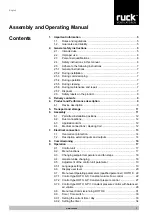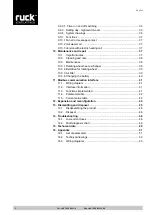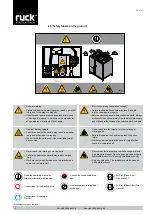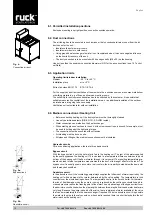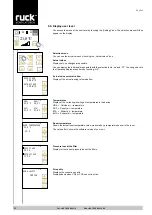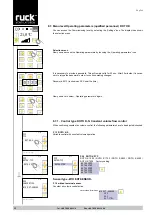
12
--
+
English
Tel. +49 7930 9211-0 Fax +49 7930 9211-150
6.4. Medium connections / Heating Coil
•
Before connecting heating coil, the duct system must be thoroughly cleaned.
•
Use only permitted sealants (DIN EN 751-2, DVGW tested).
•
Water connections as marked on the heat exchanger.
•
When making pipe connections to the unit, with screw connections, a wrench, for example, must
be used to hold against the tightening torque.
•
The connection must be executed without tension.
•
Air bleeding must be done on site.
•
All pipes and fittings of the medium connections must be insulated.
Hydraulic circuits
For air conditioning applications, there are three basic circuits:
Bypass circuit
With the bypass circuit, only the hot water is fed to the heating coil. The rest of the water supplied
by the pump bypasses the heating coil. This can lead to a temperature difference between top and
bottom of the heating coil if the flow of water through it is very small. The resulting temperature gra
-
dients can lead to false temperature measurements in the duct or to draught effects in the room. The
bypass circuit is usually used in air coolers. In air coolers, the air is partly cooled below the dew point
and thereby dehumidified.
Admixture circuit
In the admixture circuit, the circulating pump always supplies the full amount of water required by the
heating coil with an amount of hot water determined by the valve setting. The temperature is thus
constant over the whole heating surface. The temperature control is thus much better. Furthermore,
the risk of frost damage when the pump is running is reduced as the continuous circulation and in-
creased pressure reduce the freezing point of the water.The only advantage of the bypass circuit over
the admixture circuit arises when the pipe lengths between three-way ball valve and water heater are
very long. Because the pump is ahead of the valve, there is always hot water available at the valve
that can be immediately fed to the heat exchanger if required. When in admixture circuit it is possible
the water in the pipe to the valve cools, so when heat is required there is a short delay before the hot
water reaches the heating coil.
6.2. Duct connections
Fig. 4:
Connection air duct
6.1. Permitted installation positions
6.3. Application limits
Operating limits indoor installation
Medium:
-25 °C to +40 °C
Installation place:
min. +5°C
Extract air class EN 13779 ETA 1 / ETA 2
For the supply and extract ventilation of rooms where the emission sources are human metabolism
or building materials, e.g. offices, public areas, meeting rooms.
The suitability for enclosure condensation has to be checked by the customer, it is possible that
suitable measures like ventilation of the installation area, or an additional insulation of the outdoor
air intake area, are going to be necessary.
Ventilation unit not suitable for outdoor installation.
Exclusive mounting in upright position, connection nozzles upwards.
The air tubing has to be executed in such a manner that no condensate/rain or snow from the air
duct can enter the unit.
•
Insulate cold ducts in warm rooms.
•
Insulate warm ducts in cold rooms.
•
Using ground heat exchangers in winter is not recommended as it can have negative influence
on the humidity recovery of the unit.
•
The duct connection is to be mounted with 4 hexagon bolts (M8 x 20) on the housing.
Use not less than the minimum connection diameters (NS) for the air connections. (see 15. Techni
-
cal Data)
Fig. 5a:
Bypass circuit
Fig. 5b:
Admixture circuit



